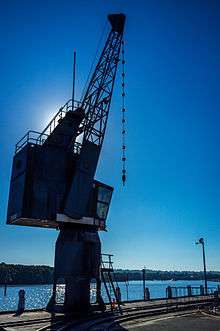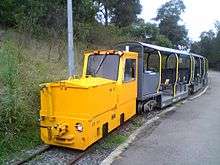Newington Armory

The RAN Armament Depot Newington was a Royal Australian Navy (RAN) armament depot at Newington, New South Wales, Australia.
History

European colonial period
The Armory is located as part of the original land grant to John Blaxland and his family, located on the shores of Parramatta River
Military magazine
The Sydney Morning Herald in October 1875 reported the recommendations of a Board appointed by the Government of the Colony of New South Wales into the removal of the Goat Island magazine. The second recommendation was "That a separate and distinct magazine for merchant's gunpowder, capable of storing about 300 tons, be established on the right bank of the Parramatta River...".[1] In May 1876, the Herald reported that the Government had set aside 3,700 pounds to purchase land on the Parramatta River at Newington.[2]
It was not until 1882, after Newington College had left Newington House for Stanmore, New South Wales, that land at Newington was acquired for "certain works for and in connection with the erection of a magazine for the storage of gunpowder and other explosives and certain buildings in connection therewith".[3]
In the event, construction at the site did not commence until 1897, and it was for a military magazine rather than the magazine for merchant's gunpowder as envisaged in 1875. A notice appearing in the Sydney Morning Herald in March 1897 calling for tenders for the erection of a "Magazine, Laboratory, Gun Cotton Store and other buildings" at the "Military Reserve at Newington" is in the name of the "New South Wales Military Forces".[4]
An article in The Cumberland Argus and Fruitgrowers’ Advocate in September 1897, reporting on the ongoing construction of the Magazine, says that: "...the Government Powder Magazine at Newington... is intended to store all the powder required for military purposes in the colony..." .[5]
In June 1895 the Sydney Morning Herald, quoting the Government Gazette of 18 June 1895 recorded the formation of:
"Ordnance Store Corps: "C" (Ordnance) Branch of the Military Secretary's Department, now a civil branch, to be converted into an Ordnance Store Corps." [6]
According to one account:
"The Corps comprised No 1 Gun Wharf Section with a Deputy Assistant Commissary General of Ordnance, a Lieutenant and Quartermaster, three Conductors of Stores and one Sergeant Artificer. No 2 Magazine Section was composed of one Conductor of Stores and three Privates; and No 3 Armourer's Section was composed of a Lieutenant and Quartermaster, with one Armourer Sergeant and two Privates. These appointments were filled by members of the permanent military forces." [7]
It is the Ordnance Store Corps, and specifically the No. 2 Magazine Section, that is likely to have been the unit that commissioned the Newington Magazine in 1898.
The New South Wales Military Forces were, at Federation in 1901, subsumed into the new Commonwealth of Australia military forces (later Australian Army). In 1902, the military staff of the Magazine, a Sergeant and three Gunners, were transferred to the new Commonwealth Ordnance Stores Corps.[8]
Railway

The site has a 2 ft (610 mm) narrow gauge electric railway with battery locomotives which was used for transporting munitions and now visitors around the armory.[9][10] The tour runs on Sundays[11] and runs on a circuit that partly goes outside the boundary of the Newington Armory into a publicly accessible area where the tracks cross over the Louise Sauvage Pathway twice.
Royal Australian Navy
The Military Magazine, as it was known at the time, remained in support of the Army until 1921, when it was transferred to the Department of Navy, to supplement the explosives storage available at the RAN Ordnance Depot at Spectacle Island.[12] During the 1920s and 1930s the depot was gradually expanded to enable mass-detonating explosives, and later all explosives, to be removed from Spectacle Island.[13] During this period it operated as a sub-depot of Spectacle Island.
World War II
During World War II the depot expanded greatly by acquisition of private property (including the Carnarvon Golf Course) and the New South Wales State Brickyards under emergency powers. During the early part of the Pacific War, an independent US Navy ammunition depot was built within the depot, and during the later part, additional storehouses were built by the Australian Government as part of its contribution to the support of the British Pacific Fleet. At the conclusion of the war, the Brickyards were returned to the New South Wales Government but most of the private property was compulsorily acquired.[14]
Post-war
During the mid-1950s the Commonwealth and New South Wales governments agreed that storage of mass-detonating explosives should be transferred to the sub-depot at Kingswood (later RAN Armament Depot, Kingswood) and this occurred progressively from about 1957. RAN Armament Depot Newington continued to store other categories of explosives, and remained the focal point for transshipment of ammunition between road and water, through the Newington Wharf.
During this time, several animals were present at the Armory including a flock of sheep to graze on the plentiful grass, and horses that pulled the carriages filled with armaments. (Curran, 2014)
During the mid-1970s the closure of the depot was first raised in connection with a proposal to hold the World Student Games in Sydney. In 1987, operational difficulties resulting from the adoption of new NATO Safety Principles for the Storage of Explosives focused navy and government attention on relocation of the depot to a new site outside Sydney. In March 1994 it was announced that the depot would close to allow the 2000 Olympic Games to be held at the adjacent Homebush Bay.
The RAN started to vacate the site in 1996, with ownership transferred to the Government of New South Wales to be developed as the Sydney 2000 Olympics Athlete's Village and the suburb of Newington. The RAN finally vacated the depot in December 1999 with the last ammunition operation conducted over the wharf on 14 December 1999. By then the southern half of the depot was being transformed into the Olympic Games athlete's village, and subsequently the suburb of Newington. The remainder, largely intact and incorporating most of the 1897 structures, has been incorporated into the Sydney Olympic Park. It is now known as the Newington Armory.
Wharf
The wharf on the Parramatta River which was used to ship ammunition in and out of the Armory while it was operating, was used as a temporary wharf by Sydney Ferries' Parramatta River services for four months from 14 January 2015 while the Sydney Olympic Park ferry wharf was rebuilt.[15][16]
Footnotes
- ↑ Sydney Morning Herald, 27 October 1875
- ↑ Sydney Morning Herald, 18 May 1876
- ↑ NSW Government Gazette 22 August 1882, No. 334 p.4317
- ↑ Sydney Morning Herald, 27 March 1897
- ↑ "NEWINGTON POWDER MAGAZINE.". The Cumberland Argus and Fruitgrowers’ Advocate. Parramatta, NSW: National Library of Australia. 4 September 1897. p. 8. Retrieved 11 November 2012.
- ↑ Sydney Morning Herald, 19 June 1895, page 3
- ↑ John D. Tilbrook, To The Warrior His Arms A History of the Ordnance Services in the Australian Army, Chapter 2 page 25
- ↑ John D. Tilbrook, To The Warrior His Arms A History of the Ordnance Services in the Australian Army, Chapter 3 page 29
- ↑ On Tour Again - Newington Armament Depot
- ↑ Newington Armament Depot
- ↑ Short Train Rides - Newington Armory
- ↑ Millenium Parklands Heritage Precinct Sydney Olympic Park Conservation Master Plan – July 2003, page 243
- ↑ Millenium Parklands Heritage Precinct Sydney Olympic Park Conservation Master Plan – July 2003, page 244
- ↑ Millenium Parklands Heritage Precinct Sydney Olympic Park Conservation Master Plan – July 2003, page 251-254
- ↑ Sydney Olympic Park Wharf upgrade to start in January Transport for NSW 8 January 2015
- ↑ Balmain East Wharf & Sydney Olympic Park Wharf closed for upgrade Transport for NSW Info 13 January 2015
References
External links
- Newington Armory - Sydney Olympic Park
- RAN Armament Depot Newington by Robert Curran
- Millenium Parklands Heritage Precinct Sydney Olympic Park Conservation Master Plan – July 2003
- To The Warrior His Arms – A History of the Ordnance Services in the Australian Army” by Major John D. Tilbrook
Coordinates: 33°49′45.22″S 151°3′47.03″E / 33.8292278°S 151.0630639°E